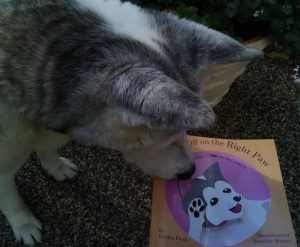
One of the best gifts you can give many furry best friends, is the gift of fellow companionship! In the beginning, there may be challenges, and supervision is a must, but it can be rewarding to watch your duo, trio or even your four-pack (if local ordinances allow) play together and know they have a pal when you aren’t around.
When we meet an animal or human for the first time however, it is so important we make a good first impression for those are hard to change. Obviously, it is never desirable to start off on the wrong foot, note, or paw when being introduced, so time the time to do it right – especially in situations where two pets will end up cohabitating or even seeing each other across the street or through the fence.
The first in my children’s book series, Don’t Judge a Book by its Cover, teaches children, and reminds adults, to treat everyone as equals. The book embraces pets as part of the family, and through the eyes of a young girl and her first fur-ever friend, readers observe indiscretions shown in unfair judging of animals, people and other things. Just like humans, man and woman’s four-legged best friend sometimes faces discrimination. The mention of specific breeds or the sight of a large dog makes some people wrongly think the animal is dangerous. Black coated pets and those with frosty or grey faces remain at shelters longer waiting to be adopted. These are injustices that can be changed, so I wanted to bring to light some of the things we are doing to animals, that we may not even realize, and reach even the youngest of ears so we can correct.
In the second installment, Start Off on the Right Paw, an older misjudged dog breed takes center stage, but when she gets a chance at a forever home…the importance of proper dog-to-dog introductions is emphasized so that the canines ‘start off on the right paw’ and can become the best of friends. It’s a lesson in taking the appropriate steps to ensure everyone gets along while expanding the message of not judging dogs, people or anything by age, stereotype or outward appearance. It’s goal is to turn first impressions into success stories!
Mary-Alice’s best friend Claire decides to adopt a ‘sister’ for her Pit Bull Rex, so the girls pay a visit to the local animal shelter. There they meet Bonsai, a Japanese Akita, very much in need of a forever home. For 6 long months, people have passed her by misjudging her to be too old, too big or too something. With the help of Claire’s mom, the girls give this loving dog a chance but must first Start Off on the Right Paw, properly introducing Bonsai to Rex and M.A.’s best friend, Mr. Rico. Along the way the girls understand the need for pet safety and excitedly await their chance to volunteer and help other animals in need.
My own beloved Mr. Rico, a black Labrador Retriever, was the inspiration for Don’t Judge a Book by its Cover, while his adopted sister, a rescued Japanese Akita named Bonsai, joins the cast in this sequel. Their baby brother Haiku will feature prominently in the third installment scheduled for release in the Fall of 2018.

Here are a few tips to make sure you start off on the right paw, but…it’s always advisable to discuss your plan with a Certified Professional Dog Training, specializing in positive methods, before you emBARK!
Introducing your Cat to a Feline Friend
It is likely your cat will initially react to a newcomer by distancing herself. She may hide refusing to acknowledge the new cat, or she may act up in an attempt to persuade the new feline to retreat.
To make the introduction go smoothly:
- Put your new cat in a spare room with the door closed for the first few days allowing both kitties a chance to adjust to each other’s scents (by sniffing under doors) without hurting each other.
- Give each a towel or blanket that the other cat has slept on to familiarize them with each other’s scent.
- If your cats exhibit personality conflicts, you can reduce tension by making sure each cat has enough personal space and personal possessions to fulfill her needs.
- To avoid territory conflicts, place litter boxes in several locations throughout your home.
Introducing Your Dog to a New Canine Family Member
Neutral turf is rule number one! If the shelter or location you are adopting from will allow you to bring your current dog there to meet your prospective new one, it is a good idea so you can see how it will work before you officially adopt. Even allowing the two dogs to sniff towels or blankets the other has slept on can be a good first step.
- For the first meeting you will need a second person so that each of you can handle one dog on-leash. Let them casually walk back and forth without letting them pay the other much attention. When that is going well (no pulling or lunging), bring the dogs together and walk both together side-by-side but avoiding contact. Make both sit while the humans talk, then walk away.
- On the next pass, let the two dogs sniff and greet each other (still on-leash). If all is going well and you are in a secured fence, drop the leashes and let them play but do not take your eyes off the dogs and be prepared to grab leashes. “Wiggly” and relaxed body posture is good. Immediately break up any staring which could result in a quarrel.
- When it’s time for them both to come home, have them enter the yard first if at all possible and then enter the house together. Make sure there are doubles of everything so that there is no need for competition – double water and food bowls, bedding, toys, etc. If either dog is known to be possessive or have resource guarding instincts, remove toys for the initial few weeks. It’s a good idea to keep food and water bowls at a distance from each other and show the new dog where his things are located.
It is best to bring a new pet home when you have several days to stay home with both pets and get them acclimated to their new situation — a weekend or when you can take a few days off, and take care not to show preferences.
Mostly, dogs and cats like stability — a routine — so any environmental or social change may have a pronounced effect on their behavior. You may find your well-mannered pooch soiling the carpet or chewing up your bed spread once a new dog joins the family. Be patient. Show them both plenty of love and affection. Animals are adaptable, but it may take time, and every animal is different. Don’t throw your hands up in distress after only a few weeks. Patience and TLC will see you through and your reward will be double the unconditional love.
Introducing Dogs and Cats
Some do fine. Some cannot live safely together. The first rule is to proceed cautiously during introductions having at least two people present, one ready to intervene with each animal if need be.
- Keep the dog on a loose lead and observe his body language at all times. The other person should pay attention to the cat’s reactions. Do not push the animals together. If the cat is not raising her hackles (the fur on her back) or hissing, allow her to move freely around the room. If the dog is not acting aggressively, praise him as he allows the cat to move around, even sniffing the dog if she wishes.
- Dogs with strong prey instincts will become focused, staring, stiffening, whining and/or barking. If these behaviors are present or if the dog lunges, calmly put the cat in another room with a tall baby gate while one person distracts the dog playing with a toy.
- Once set up with the cat in another room with all her supplies and a tall and sturdy baby gate installed in the door, allow the dog periodic loose leash visits to see the cat on the other side of the gate.
- Once the cat no longer creates such a rise in the dog, sit comfortably on the floor on the dog’s side of the gate and reach through, petting the cat and feeding her treats on her side while you do the same with the dog. Your goal is to lessen your dog’s interest in your feline companion, but in some cases, instinct is strong and the two may never be left safely alone.
If introductions are not going well, seek a professional behaviorist. In the worst circumstances, a dog can quickly injure or kill a cat and cats can inflict devastating eye injuries on dogs. Calm, patient baby steps are the best route to getting these two species comfortable around each other.
Both titles, as well as Denise Fleck’s other books, are available on Amazon and contain PAWdominant Themes for parents, teachers and rescue workers to discuss with the little (or not so little) ones in their lives. Learn more at www.PetSafetyCrusader.com/products/books
Please also view my VLOG on this topic at https://youtu.be/92qERuTV_Ug
_____________________________________________________________________________________
Denise Fleck is an award winning author and freelance writer. After extensive training, practice, more training and more practice, she developed her own Pet First-Aid & CPR curriculum and has been teaching animal life-saving skills for close to 20 years with many success stories to share. Additionally she developed a 5 month long Animal Care course for high school students in conjunction with the Burbank Unified School District and Animal Shelter. She has demonstrated animal life-saving skills on CBS –TV’s “The Doctors,” Animal Planet’s “Pit Boss,” “Kirstie Alley’s Big Life” and countless other shows. To complement her teachings, Denise created a line of Pet First-Aid Kits, posters and books for children teaching animal respect and care! Visit www.PetSafetyCrusader.com or call (818) 951-7962.
Note: The articles on this page are copyrighted. Please do not reprint or use portions for any purpose without written permission from the author. Request permission for usage by sending an email explaining how you’d like to use the materials and what parts specifically. Thank you in advance!








